Pollution Profiles, Source Identification and Health Risk Assessment of Heavy Metals in Soil near a Non-Ferrous Metal Smelting Plant
Abstract
1. Introduction
2. Materials and Methods
2.1. Studied Area and Sample Collection
2.2. Sample Pretreatment and Metal Analysis
2.3. Data Analysis
2.3.1. Geoaccumulation Index
2.3.2. Enrichment Factor
2.3.3. Human Health Risk
2.3.4. Data Processing and Analysis
3. Results and Discussion
3.1. Pollution Characteristics of Heavy Metals in Soils of the NMSP and Surrounding Area
3.2. Source Analysis of Heavy Metals in Soils of the NMSP and Surrounding Areas
3.3. Human Health Risks from the NMSP and Surrounding Area
4. Conclusions
Supplementary Materials
Author Contributions
Funding
Institutional Review Board Statement
Informed Consent Statement
Data Availability Statement
Conflicts of Interest
References
- Buruiana, D.L.; Lefter, D.; Tiron, G.L.; Balta, S.; Bordei, M. Toxicity of Heavy Metals on the Environment and Human Health. In Proceedings of the 15th International Multidisciplinary Scientific Geoconference (SGEM), Albena, Bulgaria, 18–24 June 2015; STEF92 Technology Ltd.: Albena, Bulgaria, 2015; pp. 565–571. [Google Scholar]
- Rouzi, L.; Elhamri, H.; Kalouch, S.; Salam, S.; Moutawakil, B.E.; Chaoui, H.; Badrane, N.; Fekhaoui, M.; Jouhadi, Z. Lead poisoning with encephalic and neuropathic involvement in a child: Case report. Pan. Afr. Med. J. 2022, 42, 276. [Google Scholar] [CrossRef] [PubMed]
- Wang, C.; Zhu, Y.; Long, H.; Ou, M.; Zhao, S. Relationship between blood manganese and bone mineral density and bone mineral content in adults: A population-based cross-sectional study. PLoS ONE 2022, 17, e0276551. [Google Scholar] [CrossRef] [PubMed]
- FAO; WHO. Safety evaluation of certain contaminants in food, prepared by the seventy-second meeting of the joint FAO/WHO expert committee on food additives. WHO Food Addit. Ser. 2011, 63, 153–316. [Google Scholar]
- Rahimzadeh, M.R.; Rahimzadeh, M.R.; Kazemi, S.; Moghadamnia, A.A. Cadmium toxicity and treatment: An update. Casp. J. Intern. Med. 2017, 8, 135–145. [Google Scholar]
- Nishijo, M.; Nakagawa, H.; Suwazono, Y.; Nogawa, K.; Kido, T. Causes of death in patients with Itai-itai disease suffering from severe chronic cadmium poisoning: A nested case-control analysis of a follow-up study in Japan. BMJ Open 2017, 7, e015694. [Google Scholar] [CrossRef] [PubMed]
- Liu, M.; Liu, R.; Wang, R.; Ba, Y.; Yu, F.; Deng, Q.; Huang, H. Lead-induced neurodevelopmental lesion and epigenetic landscape: Implication in neurological disorders. J. Appl. Toxicol. 2022, 1–16. [Google Scholar] [CrossRef]
- Shiani, A.; Sharafi, K.; Omer, A.K.; Kiani, A.; Karamimatin, B.; Massahi, T.; Ebrahimzadeh, G. A systematic literature review on the association between exposures to toxic elements and an autism spectrum disorder. Sci. Total Environ. 2023, 857, 159246. [Google Scholar] [CrossRef]
- Huang, X.P.; Fu, Q.; Wang, J.H. Distribution and Pollution Assessment by Index of Geoaccumulation about the Heavy Metals in Sediments of Dexing Copper Mine Rainwater Network. In IOP Conference Series: Earth and Environmental Science; IOP Publishing: Bristol, UK, 2020; Volume 455, p. 012186. [Google Scholar]
- Zeng, J.Q.; Luo, X.H.; Cheng, Y.Z.; Ke, W.S.; Hartley, W.; Li, C.X.; Jiang, J.; Zhu, F.; Xue, S.G. Spatial distribution of toxic metal(loid)s at an abandoned zinc smelting site, Southern China. J. Hazard. Mater. 2022, 425, 127970. [Google Scholar] [CrossRef]
- Wu, Y.; Li, G.; Yang, Y.; An, T. Pollution evaluation and health risk assessment of airborne toxic metals in both indoors and outdoors of the Pearl River Delta, China. Environ. Res. 2019, 179, 108793. [Google Scholar] [CrossRef]
- Yan, M.; Nie, H.; Wang, W.; Huang, Y.; Wang, J. Occurrence and Toxicological Risk Assessment of Polycyclic Aromatic Hydrocarbons and Heavy Metals in Drinking Water Resources of Southern China. Int. J. Environ. Res. Public Health 2018, 15, 1422. [Google Scholar] [CrossRef]
- Tong, S.M.; Li, H.R.; Wang, L.; Tudi, M.; Yang, L.S. Concentration, Spatial Distribution, Contamination Degree and Human Health Risk Assessment of Heavy Metals in Urban Soils across China between 2003 and 2019-A Systematic Review. Int. J. Environ. Res. Public Health 2020, 17, 3099. [Google Scholar] [CrossRef] [PubMed]
- Kang, M.J.; Yu, S.; Jeon, S.W.; Jung, M.C.; Kwon, Y.K.; Lee, P.K.; Chae, G. Mobility of metal(loid)s in roof dusts and agricultural soils surrounding a Zn smelter: Focused on the impacts of smelter-derived fugitive dusts. Sci. Total Environ. 2021, 757, 143884. [Google Scholar] [CrossRef] [PubMed]
- Ma, D.; Zhong, H.; Lv, J.; Wang, Y.; Jiang, G. Levels, distributions, and sources of legacy and novel per- and perfluoroalkyl substances (PFAS) in the topsoil of Tianjin, China. J. Environ. Sci. (China) 2022, 112, 71–81. [Google Scholar] [CrossRef] [PubMed]
- Holzinger, A.; Mair, M.M.; Lücker, D.; Seidenath, D.; Opel, T.; Langhof, N.; Otti, O.; Feldhaar, H. Comparison of fitness effects in the earthworm Eisenia fetida after exposure to single or multiple anthropogenic pollutants. Sci. Total Environ. 2022, 838, 156387. [Google Scholar] [CrossRef] [PubMed]
- Luo, Y.; Wang, Z.; Zhang, Z.L.; Huang, F.Y.; Jia, W.J.; Zhang, J.Q.; Feng, X.Y. Characteristics and source analysis of potentially toxic elements pollution in atmospheric fallout around non-ferrous metal smelting slag sites-taking southwest China as an example. Environ. Sci. Pollut. Res. Int. 2022, 1–12. [Google Scholar] [CrossRef]
- Carrizales, L.; Razo, I.; Tellez-Hernandez, J.I.; Torres-Nerio, R.; Torres, A.; Batres, L.E.; Cubillas, A.C.; Diaz-Barriga, F. Exposure to arsenic and lead of children living near a copper-smelter in San Luis Potosi, Mexico: Importance of soil contamination for exposure of children. Environ. Res. 2006, 101, 1–10. [Google Scholar] [CrossRef]
- CDC. Preventing Lead Poisoning in Young Children; US Department of Health and Human Services, Centers for Disease Control and Prevention: Atlanta, GA, USA, 1991.
- Zhang, J.; Sun, X.; Deng, J.; Li, G.; Li, Z.; Jiang, J.; Wu, Q.; Duan, L. Emission characteristics of heavy metals from a typical copper smelting plant. J. Hazard. Mater. 2022, 424, 127311. [Google Scholar] [CrossRef]
- Fry, K.L.; Wheeler, C.A.; Gillings, M.M.; Flegal, A.R.; Taylor, M.P. Anthropogenic contamination of residential environments from smelter As, Cu and Pb emissions: Implications for human health. Environ. Pollut. 2020, 262, 114235. [Google Scholar] [CrossRef]
- Kumkrong, P.; Dy, E.; Tyo, D.D.; Jiang, C.; Gedara Pihilligawa, I.; Kingston, D.; Mercier, P.H.J. Investigation of metal mobility in gold and silver mine tailings by single-step and sequential extractions. Environ. Monit. Assess. 2022, 194, 423. [Google Scholar] [CrossRef]
- MEPC. Soil and Sediment-Determination of Aqua Regia Extracts of 12 Metal Elements-Inductively Coupled Plasma Mass Spectrometry; Ministry of Environmental Protection of China: Beijing, China, 2016. [Google Scholar]
- Zhu, Y.; Zhu, J.; Wang, B.; Xiao, M.; Li, L. Pollution characteristics and probabilistic health risk of potentially hazardous elements in soils near a typical coal mine in Panzhihua City, Southwest China. Environ. Monit. Assess. 2022, 195, 230. [Google Scholar] [CrossRef]
- Müller, G. Index of geoaccumulation in sediments of the Rhine River. Geol. J. 1969, 2, 108–118. [Google Scholar]
- CNEMC. The Background Concentrations of Soil Elements of China; China Environmental Science Press: Beijing, China, 1990. [Google Scholar]
- Palma, P.; Penha, A.M.; Novais, M.H.; Fialho, S.; Lima, A.; Catarino, A.; Mourinha, C.; Alvarenga, P.; Iakunin, M.; Rodrigues, G.; et al. Integrative toolbox to assess the quality of freshwater sediments contaminated with potentially toxic metals. Environ. Res. 2022, 217, 114798. [Google Scholar] [CrossRef] [PubMed]
- Solgi, E.; Esmaili-Sari, A.; Riyahi-Bakhtiari, A.; Hadipour, M. Soil contamination of metals in the three industrial estates, Arak, Iran. Bull. Environ. Contam. Toxicol. 2012, 88, 634–638. [Google Scholar] [CrossRef] [PubMed]
- Napoletano, P.; Guezgouz, N.; Di Iorio, E.; Colombo, C.; Guerriero, G.; De Marco, A. Anthropic impact on soil heavy metal contamination in riparian ecosystems of northern Algeria. Chemosphere 2022, 313, 137522. [Google Scholar] [CrossRef]
- Yılmaz, C.H. Heavy metals and their sources, potential pollution situations and health risks for residents in Adıyaman province agricultural lands, Türkiye. Environ. Geochem. Health 2022, 1–19. [Google Scholar] [CrossRef]
- Loska, K.; Wiechula, D.; Korus, I. Metal contamination of farming soils affected by industry. Environ. Int. 2004, 30, 159–165. [Google Scholar] [CrossRef]
- Ediagbonya, T.F.; Ajayi, S. Risk assessment and elemental quantification of anthropogenic activities in soil. Environ. Geochem. Health 2021, 43, 4891–4904. [Google Scholar] [CrossRef]
- USEPA. Exposure Factors Handbook, final ed.; US Environmental Protection Agency: Washington, DC, USA, 2011.
- MEPC. Technical Guidelines Risk Assessment Contaminated Sites; Ministry of Environmental Protection of China: Beijing, China, 2014. [Google Scholar]
- Madadi, R.; Mohamadi, S.; Rastegari, M.; Karbassi, A.; Rakib, M.R.J.; Khandaker, M.U.; Faruque, M.R.I.; Idris, A.M. Health risk assessment and source apportionment of potentially toxic metal(loid)s in windowsill dust of a rapidly growing urban settlement, Iran. Sci. Rep. 2022, 12, 19736. [Google Scholar] [CrossRef]
- Kong, J.; Han, M.; Cao, X.; Cheng, X.; Yang, S.; Li, S.; Sun, C.; He, H. Sedimentary spatial variation, source identification and ecological risk assessment of parent, nitrated and oxygenated polycyclic aromatic hydrocarbons in a large shallow lake in China. Sci. Total Environ. 2022, 863, 160926. [Google Scholar] [CrossRef]
- Samecka-Cymerman, A.; Stankiewicz, A.; Kolon, K.; Kempers, A.J. Bioindication of Trace Metals in Brachythecium rutabulum Around a Copper Smelter in Legnica (Southwest Poland): Use of a New Form of Data Presentation in the Form of a Self-Organizing Feature Map. Arch. Environ. Con. Tox. 2009, 56, 717–722. [Google Scholar] [CrossRef]
- Jordanova, N.; Jordanova, D.; Tcherkezova, E.; Georgieva, B.; Ishlyamski, D. Advanced mineral magnetic and geochemical investigations of road dusts for assessment of pollution in urban areas near the largest copper smelter in SE Europe. Sci. Total Environ. 2021, 792, 148402. [Google Scholar] [CrossRef] [PubMed]
- Wang, Z.; Bai, L.; Zhang, Y.; Zhao, K.; Wu, J.; Fu, W. Spatial variation, sources identification and risk assessment of soil heavy metals in a typical Torreya grandis cv. Merrillii plantation region of southeastern China. Sci. Total Environ. 2022, 849, 157832. [Google Scholar] [CrossRef] [PubMed]
- Xu, J.; Li, Y.; Wang, S.; Long, S.; Wu, Y.; Chen, Z. Sources, transfers and the fate of heavy metals in soil-wheat systems: The case of lead (Pb)/zinc (Zn) smelting region. J. Hazard. Mater. 2023, 441, 129863. [Google Scholar] [CrossRef] [PubMed]
- Hoshyari, E.; Hassanzadeh, N.; Keshavarzi, B.; Jaafarzadeh, N.; Rezaei, M. Spatial distribution, source apportionment, and ecological risk assessment of elements (PTEs, REEs, and ENs) in the surface soil of shiraz city (Iran) under different land-use types. Chemosphere 2023, 311, 137045. [Google Scholar] [CrossRef] [PubMed]
- Sarkodie, E.K.; Jiang, L.; Li, K.; Yang, J.; Guo, Z.; Shi, J.; Deng, Y.; Liu, H.; Jiang, H.; Liang, Y.; et al. A review on the bioleaching of toxic metal(loid)s from contaminated soil: Insight into the mechanism of action and the role of influencing factors. Front. Microbiol. 2022, 13, 1049277. [Google Scholar] [CrossRef] [PubMed]
- Rueda-Garzon, L.F.; Miranda-Avilés, R.; Carrillo-Chávez, A.; Puy-Alquiza, M.J.; Morales-Martinez, J.L.; Zanor, G. Contamination assessment and potential sources of heavy metals and other elements in sediments of a basin impacted by 500 years of mining in central Mexico. Environ. Monit. Assess. 2022, 194, 729. [Google Scholar] [CrossRef] [PubMed]
- Cai, L.M.; Wang, Q.S.; Luo, J.; Chen, L.G.; Zhu, R.L.; Wang, S.; Tang, C.H. Heavy metal contamination and health risk assessment for children near a large Cu-smelter in central China. Sci. Total Environ. 2019, 650, 725–733. [Google Scholar] [CrossRef]
- Wang, H.Z.; Cai, L.M.; Wang, Q.S.; Hu, G.C.; Chen, L.G. A comprehensive exploration of risk assessment and source quantification of potentially toxic elements in road dust: A case study from a large Cu smelter in central China. Catena 2021, 196, 104930. [Google Scholar] [CrossRef]
- Bandara, T.; Krohn, C.; Jin, J.; Chathurika, J.; Franks, A.; Xu, J.; Potter, I.D.; Tang, C. The effects of biochar aging on rhizosphere microbial communities in cadmium-contaminated acid soil. Chemosphere 2022, 303, 135153. [Google Scholar] [CrossRef]
- Soltani-Gerdefaramarzi, S.; Ghasemi, M.; Gheysouri, M. Pollution, human health risk assessment and spatial distribution of toxic metals in urban soil of Yazd City, Iran. Environ. Geochem. Health 2021, 43, 3469–3484. [Google Scholar] [CrossRef]
- Guo, X.; Li, S.; Zhang, Y.; Wu, B.; Guo, W. Applications of dynamic simulation for source analysis of soil pollutants based on atmospheric diffusion and deposition model. Sci. Total Environ. 2022, 839, 156057. [Google Scholar] [CrossRef] [PubMed]
- Xia, Y.; Gao, T.; Liu, Y.; Wang, Z.; Liu, C.; Wu, Q.; Qi, M.; Lv, Y.; Li, F. Zinc isotope revealing zinc’s sources and transport processes in karst region. Sci. Total Environ. 2020, 724, 138191. [Google Scholar] [CrossRef] [PubMed]
- Yuan, B.; Cao, H.; Du, P.; Ren, J.; Chen, J.; Zhang, H.; Zhang, Y.; Luo, H. Source-oriented probabilistic health risk assessment of soil potentially toxic elements in a typical mining city. J. Hazard. Mater. 2023, 443, 130222. [Google Scholar] [CrossRef] [PubMed]
- Sun, J.; Zhao, M.; Cai, B.; Song, X.; Tang, R.; Huang, X.; Huang, H.; Huang, J.; Fan, Z. Risk assessment and driving factors of trace metal(loid)s in soils of China. Environ. Pollut. 2022, 309, 119772. [Google Scholar] [CrossRef]
- Yan, Y.; Chen, R.; Jin, H.; Rukh, G.; Wang, Y.; Cui, S.; Liu, D. Pollution Characteristics, Sources, and Health Risk Assessments of Potentially Toxic Elements in Community Garden Soil of Lin’an, Zhejiang, China. Bull. Environ. Contam. Toxicol. 2022, 109, 1106–1116. [Google Scholar] [CrossRef]
- Lee, C.S.; Li, X.; Shi, W.; Cheung, S.C.; Thornton, I. Metal contamination in urban, suburban, and country park soils of Hong Kong: A study based on GIS and multivariate statistics. Sci. Total Environ. 2006, 356, 45–61. [Google Scholar] [CrossRef]
- Ray, I.; Das, R.; Chua, S.L.; Wang, X. Seasonal variation of atmospheric Pb sources in Singapore-Elemental and lead isotopic compositions of PM(10) as source tracer. Chemosphere 2022, 307, 136029. [Google Scholar] [CrossRef]
- Dong, B.; Zhang, R.; Gan, Y.; Cai, L.; Freidenreich, A.; Wang, K.; Guo, T.; Wang, H. Multiple methods for the identification of heavy metal sources in cropland soils from a resource-based region. Sci. Total Environ. 2019, 651, 3127–3138. [Google Scholar] [CrossRef]
- Xu, D.M.; Fu, R.B.; Liu, H.Q.; Guo, X.P. Current knowledge from heavy metal pollution in Chinese smelter contaminated soils, health risk implications and associated remediation progress in recent decades: A critical review. J. Clean. Prod. 2021, 286, 124989. [Google Scholar] [CrossRef]
- Cánovas, C.R.; Quispe, D.; Macías, F.; Callejón-Leblic, B.; Arias-Borrego, A.; García-Barrera, T.; Nieto, J.M. Potential release and bioaccessibility of metal/loids from mine wastes deposited in historical abandoned sulfide mines. Environ. Pollut. 2023, 316, 120629. [Google Scholar] [CrossRef]
- Liu, J.; Zhou, R.; Yu, J.; Guo, L.; Li, X.; Xiao, C.; Hou, H.; Chi, R.; Feng, G. Simultaneous removal of lead, manganese, and copper released from the copper tailings by a novel magnetic modified biosorbent. J. Environ. Manag. 2022, 322, 116157. [Google Scholar] [CrossRef] [PubMed]
- Liang, J.; Liu, Z.; Tian, Y.; Shi, H.; Fei, Y.; Qi, J.; Mo, L. Research on health risk assessment of heavy metals in soil based on multi-factor source apportionment: A case study in Guangdong Province, China. Sci. Total Environ. 2023, 858, 159991. [Google Scholar] [CrossRef] [PubMed]
- Papanikolaou, N.C.; Hatzidaki, E.G.; Belivanis, S.; Tzanakakis, G.N.; Tsatsakis, A.M. Lead toxicity update. A brief review. Med. Sci. Monit. 2005, 11, RA329–RA336. [Google Scholar] [PubMed]
- USEPA. Screening Levels (RSL) for Chemical Contaminants at Superfund Sites; U.S. Environmental Protection Agency: Washington, DC, USA, 2011.
- Duan, X. Summary of Chinese Population Exposure Parameters Manual; China Environmental Press: Beijing, China, 2014. [Google Scholar]
- Duan, X. Highlight of Chinese Children’s Exposure Factors Handbook; China Environmental Press: Beijing, China, 2016. [Google Scholar]
- Sutherland, R.A. Bed sediment-associated trace metals in an urban stream, Oahu, Hawaii. Environ. Geol. 2000, 39, 611–627. [Google Scholar] [CrossRef]
- MEEPRC. Soil Environmental Quality-Risk Control Standard for Soil Contamination of Agricultural Land (GB15618-2018); Ministry of Ecology and Environment of the People’s Republic of China: Beijing, China, 2018.
- MEEPRC. Soil Environmental Quality-Risk Control Standard for Soil Contamination of Development Land (GB36600-2018); Ministry of Ecology and Environment of the People’s Republic of China: Beijing, China, 2018.
- Ferreira-Baptista, L.; De Miguel, E. Geochemistry and risk assessment of street dust in Luanda, Angola: A tropical urban environment. Atmos. Environ. 2005, 39, 4501–4512. [Google Scholar] [CrossRef]
- Jiang, Y.; Chao, S.; Liu, J.; Yang, Y.; Chen, Y.; Zhang, A.; Cao, H. Source apportionment and health risk assessment of heavy metals in soil for a township in Jiangsu Province, China. Chemosphere 2017, 168, 1658–1668. [Google Scholar] [CrossRef]
- USEPA. Environmental Protection Agency, Region 3, Risk Based Screening Tables (RSLs); Unites States Environmental Protection Agency: Washington, DC, USA, 2021.
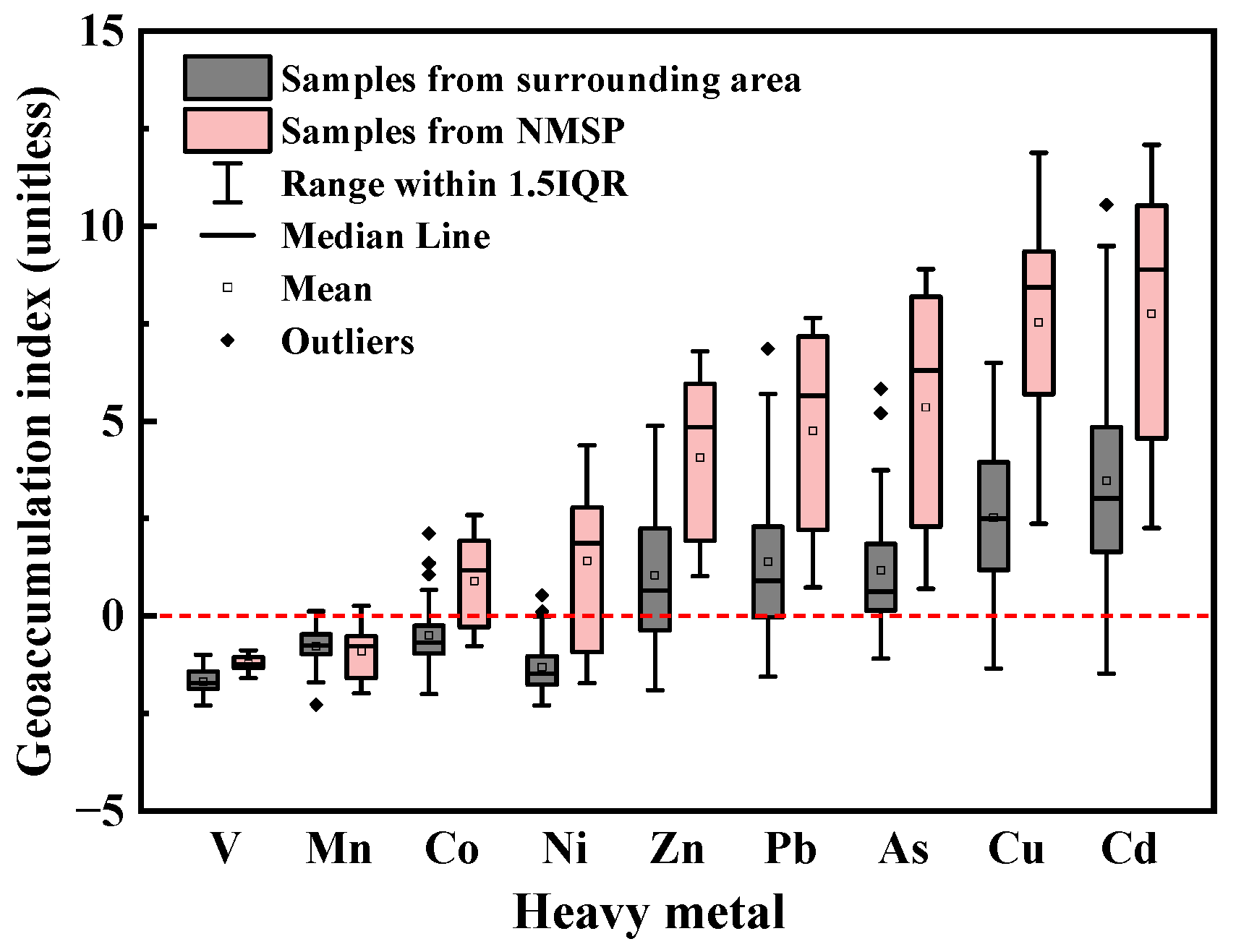
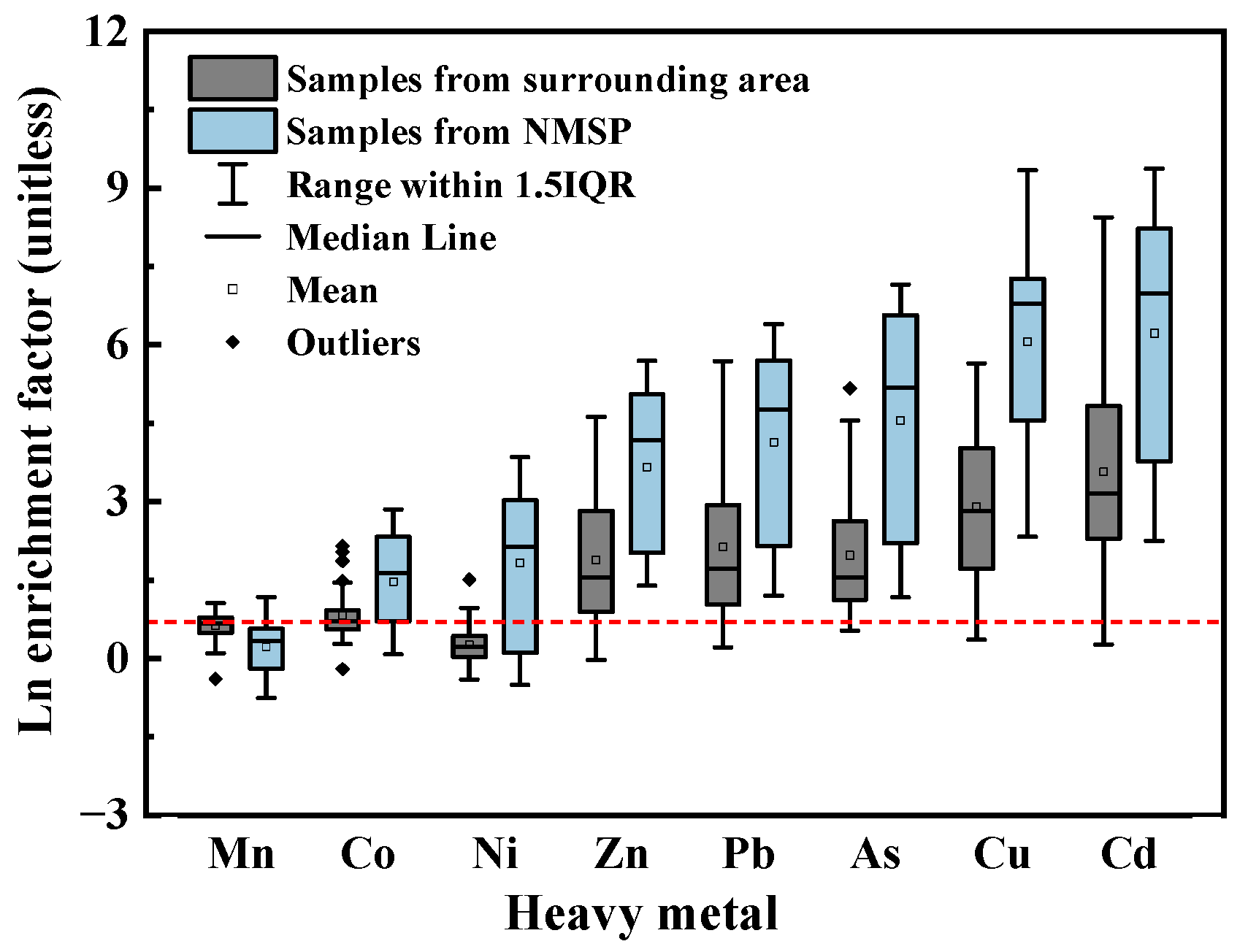
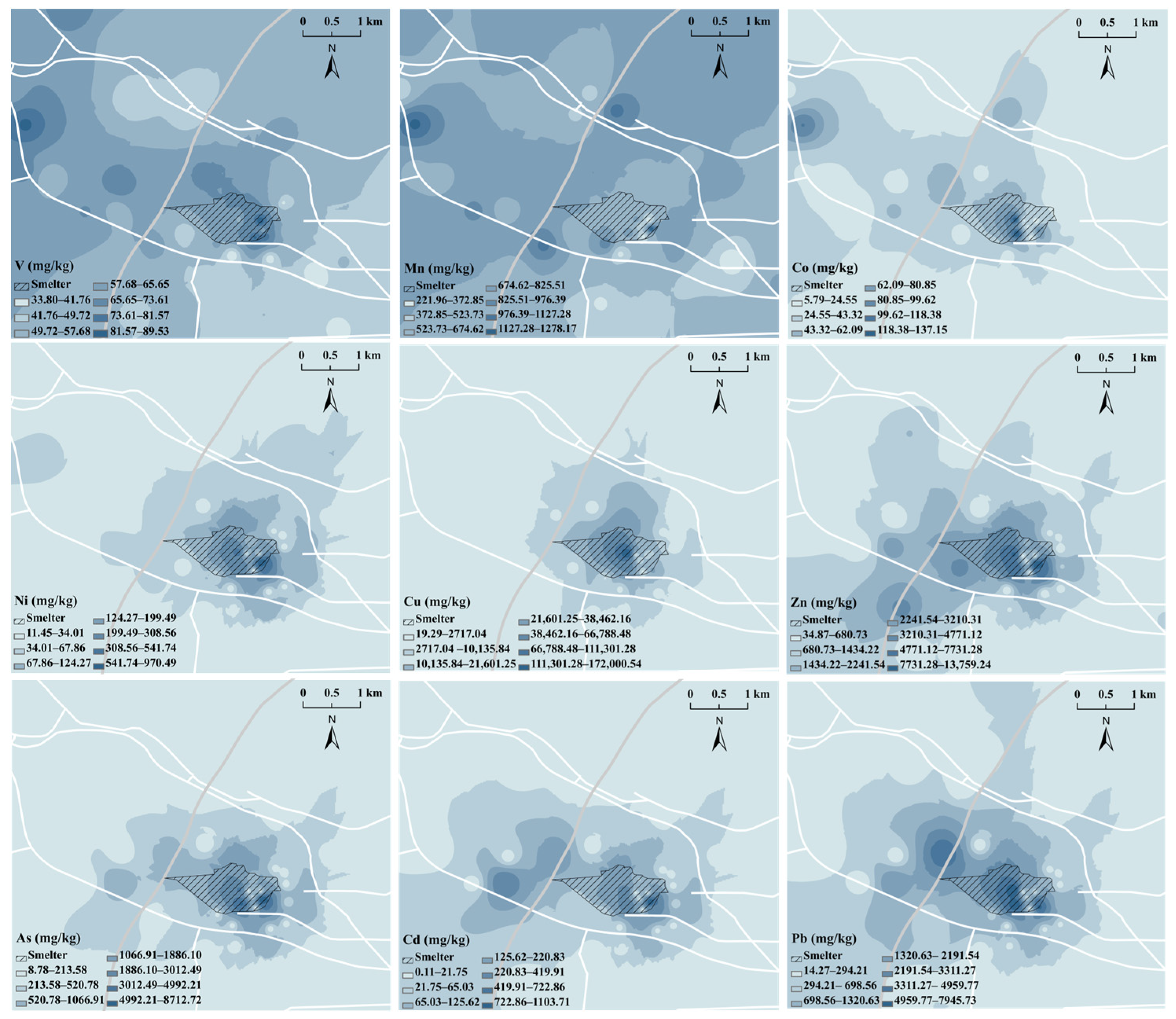
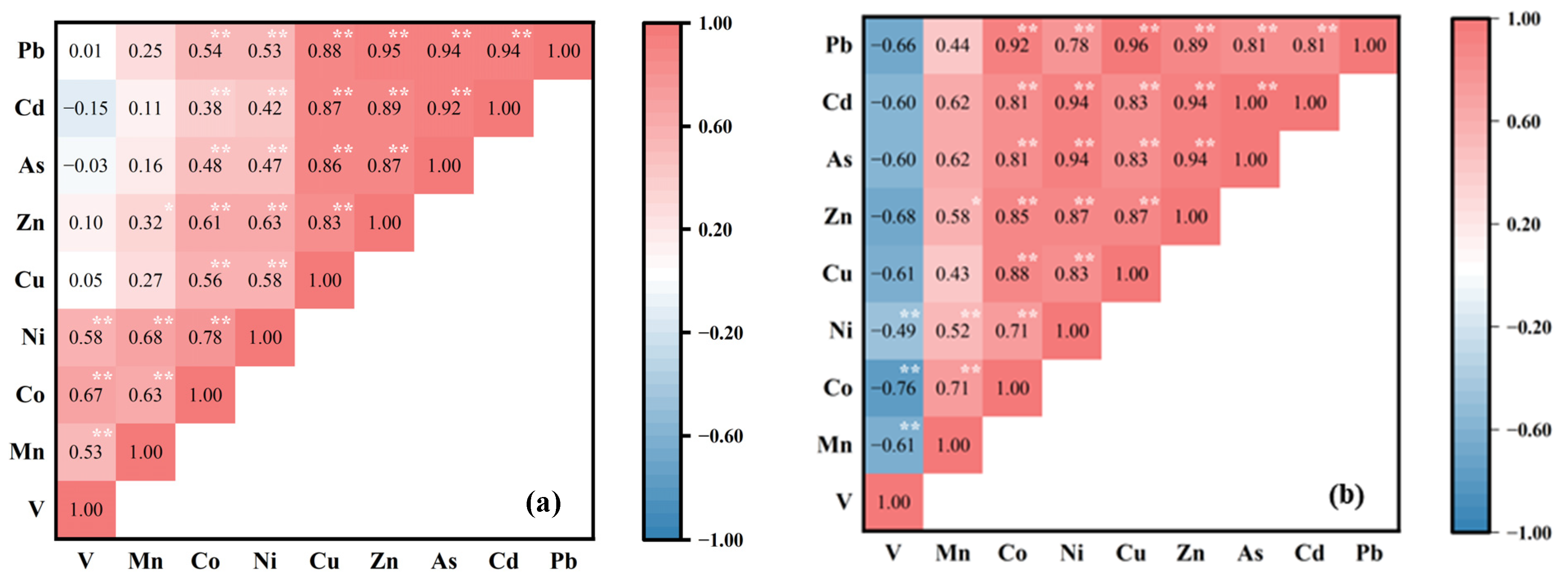
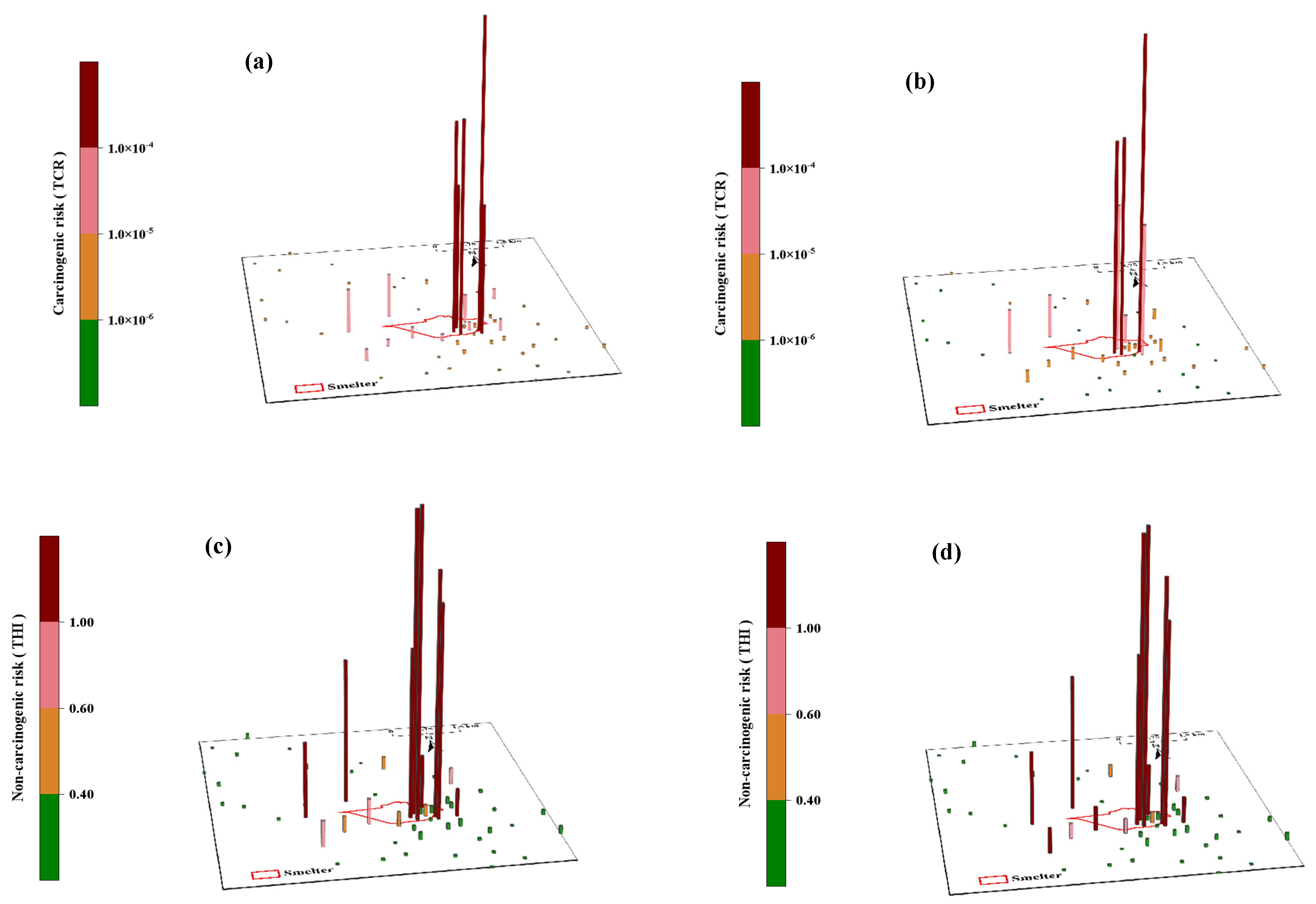
| Element | Min | Median | Max | Mean | Standard Deviation | Coefficient of Variation | BGV |
|---|---|---|---|---|---|---|---|
| Surrounding area | |||||||
| V | 33.78 | 50.32 | 83.16 | 52.68 | 10.42 | 0.20 | 110.20 |
| Mn | 221.19 | 634.84 | 1159.72 | 647.07 | 180.10 | 0.28 | 712.00 |
| Co | 5.78 | 14.38 | 100.18 | 19.79 | 16.66 | 0.84 | 15.40 |
| Ni | 11.43 | 20.02 | 81.12 | 25.18 | 13.76 | 0.55 | 37.30 |
| Cu | 18.18 | 264.96 | 4160.19 | 583.37 | 820.66 | 1.41 | 30.70 |
| Zn | 33.64 | 196.30 | 3676.61 | 606.95 | 906.35 | 1.49 | 83.60 |
| As | 8.65 | 28.44 | 1049.96 | 92.30 | 181.05 | 1.96 | 12.30 |
| Cd | 0.09 | 2.06 | 382.28 | 19.38 | 61.16 | 3.16 | 0.17 |
| Pb | 13.61 | 74.62 | 4642.77 | 303.55 | 732.05 | 2.41 | 26.70 |
| NMSP | |||||||
| V | 54.88 | 70.32 | 89.59 | 71.70 | 10.02 | 0.14 | 110.20 |
| Mn | 270.67 | 625.15 | 1283.20 | 626.72 | 276.11 | 0.44 | 712.00 |
| Co | 13.58 | 53.88 | 138.89 | 60.37 | 45.07 | 0.75 | 15.40 |
| Ni | 16.94 | 222.24 | 1163.26 | 343.60 | 387.25 | 1.13 | 37.30 |
| Cu | 238.24 | 16,044.90 | 173,887.37 | 31,627.73 | 49,699.53 | 1.57 | 30.70 |
| Zn | 254.13 | 4247.79 | 13,827.58 | 4789.46 | 4495.54 | 0.94 | 83.60 |
| As | 29.87 | 1910.62 | 8759.41 | 2763.95 | 2943.77 | 1.07 | 12.30 |
| Cd | 1.22 | 154.14 | 1110.12 | 316.33 | 402.19 | 1.27 | 0.17 |
| Pb | 66.53 | 2097.49 | 8017.90 | 3026.90 | 3004.71 | 0.99 | 26.70 |
| Metal | Surrounding Area | NMSP | ||
|---|---|---|---|---|
| PC1 | PC2 | PC1 | PC2 | |
| V | −0.09 | 0.76 | −0.27 | −0.74 |
| Mn | −0.03 | 0.87 | 0.83 | 0.25 |
| Co | 0.34 | 0.79 | 0.42 | 0.87 |
| Ni | 0.37 | 0.79 | 0.93 | 0.11 |
| Cu | 0.41 | 0.66 | −0.02 | 0.92 |
| Zn | 0.75 | 0.15 | 0.82 | 0.53 |
| As | 0.97 | 0.10 | 0.93 | 0.34 |
| Cd | 0.91 | 0.08 | 0.97 | 0.12 |
| Pb | 0.86 | 0.19 | 0.30 | 0.89 |
| Eigenvalue > 1 | 3.50 | 3.10 | 4.36 | 3.44 |
| % of variance | 38.86 | 34.44 | 48.50 | 38.23 |
| Cumulative% | 38.86 | 73.30 | 48.50 | 86.73 |
Disclaimer/Publisher’s Note: The statements, opinions and data contained in all publications are solely those of the individual author(s) and contributor(s) and not of MDPI and/or the editor(s). MDPI and/or the editor(s) disclaim responsibility for any injury to people or property resulting from any ideas, methods, instructions or products referred to in the content. |
© 2023 by the authors. Licensee MDPI, Basel, Switzerland. This article is an open access article distributed under the terms and conditions of the Creative Commons Attribution (CC BY) license (https://creativecommons.org/licenses/by/4.0/).
Share and Cite
Qi, M.; Wu, Y.; Zhang, S.; Li, G.; An, T. Pollution Profiles, Source Identification and Health Risk Assessment of Heavy Metals in Soil near a Non-Ferrous Metal Smelting Plant. Int. J. Environ. Res. Public Health 2023, 20, 1004. https://doi.org/10.3390/ijerph20021004
Qi M, Wu Y, Zhang S, Li G, An T. Pollution Profiles, Source Identification and Health Risk Assessment of Heavy Metals in Soil near a Non-Ferrous Metal Smelting Plant. International Journal of Environmental Research and Public Health. 2023; 20(2):1004. https://doi.org/10.3390/ijerph20021004
Chicago/Turabian StyleQi, Mengdie, Yingjun Wu, Shu Zhang, Guiying Li, and Taicheng An. 2023. "Pollution Profiles, Source Identification and Health Risk Assessment of Heavy Metals in Soil near a Non-Ferrous Metal Smelting Plant" International Journal of Environmental Research and Public Health 20, no. 2: 1004. https://doi.org/10.3390/ijerph20021004
APA StyleQi, M., Wu, Y., Zhang, S., Li, G., & An, T. (2023). Pollution Profiles, Source Identification and Health Risk Assessment of Heavy Metals in Soil near a Non-Ferrous Metal Smelting Plant. International Journal of Environmental Research and Public Health, 20(2), 1004. https://doi.org/10.3390/ijerph20021004








